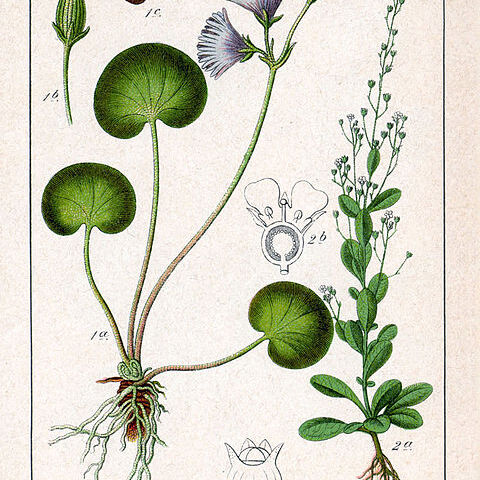Herbs annual or perennial. Stems erect, sometimes woody at base. Leaves alternate or sometimes basal leaves forming a rosette. Inflorescences terminal, racemose to corymbose. Calyx 5-lobed; tube fused with ovary at base or to middle. Corolla white, campanulate, 5-lobed. Stamens 5, inserted in corolla tube; filaments very short; anthers obtuse or acute at apex; staminodes 5, linear to ligulate, alternating with corolla lobes. Ovary semi-inferior; ovules numerous, semi-anatropous; style short, stigma obtuse to capitellate. Capsule globose, dehiscing by valves.
Cal campanulate, its broadly triangular lobes shorter than the tube; cor deeply 5-lobed, with a minute, scale-like staminode in each sinus; stamens about equaling the cor-tube and inserted near its base; ovary ca two thirds inferior; style very short or obsolete; stigma capitellate; capsule globose, dehiscent by 5 valves as far as the base of the cal-lobes; perennial herbs with entire lvs and small white fls in terminal (or in part axillary) racemes on slender pedicels bracteolate near the middle. 10, cosmop.
Fls in terminal or axillary bracted racemes or solitary. Stamens alt. with staminodes, on very short filaments. Ovary adnate to receptacle in lower half. Capsule 5-valved; seeds ∞, minute; embryo transverse. Annual or perennial herbs with alt. lvs. Some 100 spp., mainly of southern hemisphere.
Ovary globose; style short, stigma obtuse or capitellate; ovules numerous; placentation free–central.
Annual and perennial herbs; stems erect or rarely procumbent, sometimes with a basal leaf–rosette.
Flowers in racemes or corymbs; bracts inserted at the base or near the middle of pedicels.
Stamens borne on the corolla–tube, oppositipetalous, alternating with small staminodes.
Calyx partly adnate to ovary, the limb 5–lobed, persistent.
Leaves alternate, linear, oblong or spathulate, entire.
Capsule ovoid or globose, dehiscing by 5 valves.
Corolla subcampanulate, the limb 5–lobed.
Seeds numerous, angular.


